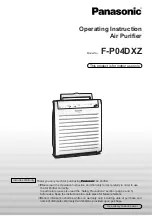
66369-YIM-D-1004
Unitary Products Group
49
SHUT DOWN
1.
Set the thermostat to highest temperature setting.
2.
Turn off the electrical power to the unit.
START-UP (GAS HEAT)
PRE-START CHECK LIST
Complete the following checks before starting the unit.
1.
Check the type of gas being supplied. Be sure that
it is the same as listed on the unit nameplate.
2.
Make sure that the vent and combustion air hoods
have been properly installed.
OPERATING INSTRUCTIONS
TO LIGHT PILOT AND MAIN BURNERS:
1.
Turn “off” electric power to unit.
2.
Turn room thermostat to lowest setting.
3.
Turn gas valve knob or switch to “on” position.
4.
Turn “on” electric power to unit.
5.
Set room thermostat to desired temperature.
(If thermostat “set” temperature is above room tem-
perature, pilot burner ignition will occur and, after
an interval to prove pilot flame, main burners will
ignite).
TO SHUT DOWN:
1.
Turn “off” electric power to unit.
2.
Depress knob of gas valve while turning to “off”
position, or turn gas valve switch to “off” position.
POST-START CHECK LIST (GAS)
After the entire control circuit has been energized and
the heating section is operating, make the following
checks:
1.
Check for gas leaks in the unit piping as well as the
supply piping.
2.
Check for correct manifold gas pressures. See
“Checking Gas Input” Page 50.
3.
Check the supply gas pressure. It must be within
the limits shown on rating nameplate. Supply
pressure should be checked with all gas
appliances in the building at full fire. At no time
should the standby gas line pressure exceed 13",
nor the operating pressure drop below 5.0" for
natural gas units. If gas pressure is outside these
limits, contact the local gas utility for corrective
action.
MANIFOLD GAS PRESSURE ADJUSTMENT
Small adjustments to the high-fire gas flow may be
made by turning the pressure regulator adjusting screw
on the automatic gas valve.
This furnace is equipped with an intermittent
pilot and automatic re-ignition system. DO
NOT attempt to manually light the pilot.
FIRE OR EXPLOSION HAZARD
FAILURE TO FOLLOW THE SAFETY WARN-
ING EXACTLY COULD RESULT IN SERIOUS
INJURY, DEATH OR PROPERTY DAMAGE.
NEVER TEST FOR GAS LEAKS WITH AN
OPEN FLAME. USE A COMMERICALLY
AVAILABLE SOAP SOLUTION MADE SPE-
CIFICALLY FOR THE DETECTION OF
LEAKS TO CHECK ALL CONNECTIONS. A
FIRE OR EXPLOSION MAY RESULT CAUS-
ING PROPERTY DAMAGE, PERSONAL
INJURY OR LOSS OF LIFE.
FIGURE 19 - TYPICAL GAS VALVES











































